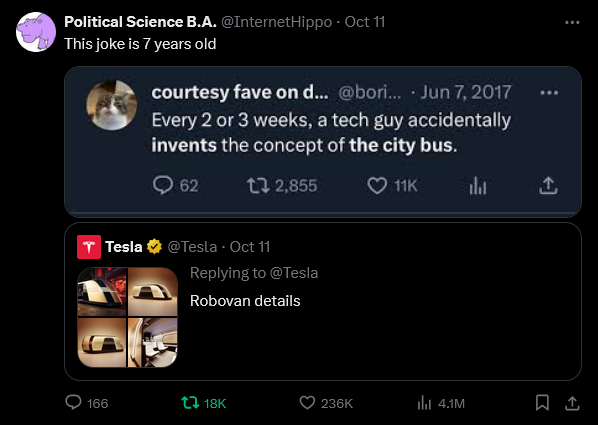this post was submitted on 13 Oct 2024
1173 points (98.8% liked)
Microblog Memes
8888 readers
1832 users here now
A place to share screenshots of Microblog posts, whether from Mastodon, tumblr, ~~Twitter~~ X, KBin, Threads or elsewhere.
Created as an evolution of White People Twitter and other tweet-capture subreddits.
Rules:
- Please put at least one word relevant to the post in the post title.
- Be nice.
- No advertising, brand promotion or guerilla marketing.
- Posters are encouraged to link to the toot or tweet etc in the description of posts.
Related communities:
founded 2 years ago
MODERATORS
you are viewing a single comment's thread
view the rest of the comments
view the rest of the comments

Having lived in several countries in Europe, in and around major cities, I have actually chosen the train over even the tube (aka subway) because it's significantly faster for longer distances (fewer stops, better acceleration) and in general more pleasant (a bit more space, actual open spaces outside the windows rather than just dark walls).
In my experience, trains, subway and buses have different optimal use cases: trains for longer distance (in a city context that's 20+ km) mass transportation of people to and from hub points in the city (they basically feed people to and from cities), the subway distributes people around the city center and buses are what feeds the trains and tube stations in the areas further away from the city center (were the subway coverage is far more spread out) and in cities without a subway they do the work of the subway (but they're less efficient than one).
Note that I'm not talking about the use case of trains to transporting people between different cities at long distances (50km+), but a different use case which is of trains for commuting which feed people from the suburbs and satellite cities to a main city and back.
Trams basically fit the same niche as the subway when there's no subway - they're much cheaper do deploy but can get stuck in traffic unless the tram lines are in physically segregated lanes from automobile traffic.
The way I've seen buses used in general is them set-up to going around to "every nook and crany" in residential areas plus with main tube/train stations as part of their route (often at the start and end of the bus line), so they have pretty windy routes and are a pretty slow way to do longer (5km+) distances since they're really there to feed people to and from the train and tube lines so are trying to cover as much of the residentia areas as possible hence travel back and forth in out of the way places and stop a lot.
Buses are also used in the city centers when there is good subway coverage but there they tend to just be secondary to the subway, generally just making up for gaps or other flaws in the subway network design (for example, parallel subway lines which only join far away so to do the trip with the subway you would have to go all the away around so the bus has a direct route) and as you get further out from the city center and the subway lines open up a spread out to cover those areas which end up too far from a subway station.
When the timetables of those things are properly synched it's really amazing: you can be living in a suburban area or smaller village outside the city proper, use a bus (or a bicycle, or walk) to get to the train station, catch a train to a main station in the city center and in there switch to the subway which takes you to a station near your destination were you just exit and then just walk to your final destination (with a proper subway service, in the central area of the city you seldom have to walk more than 500m to get anywhere from the nearest subway station) and you've spent maybe 30 - 45m to get from a house or appartment in the suburbs to an office in the center of a major city, zero chance of getting stuck in traffic, no worries about having to find a parking space, way less exposure to polution that if driving.